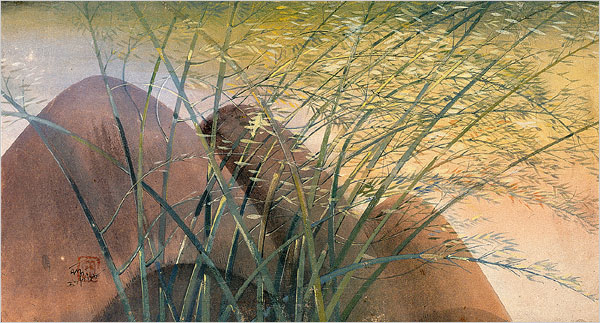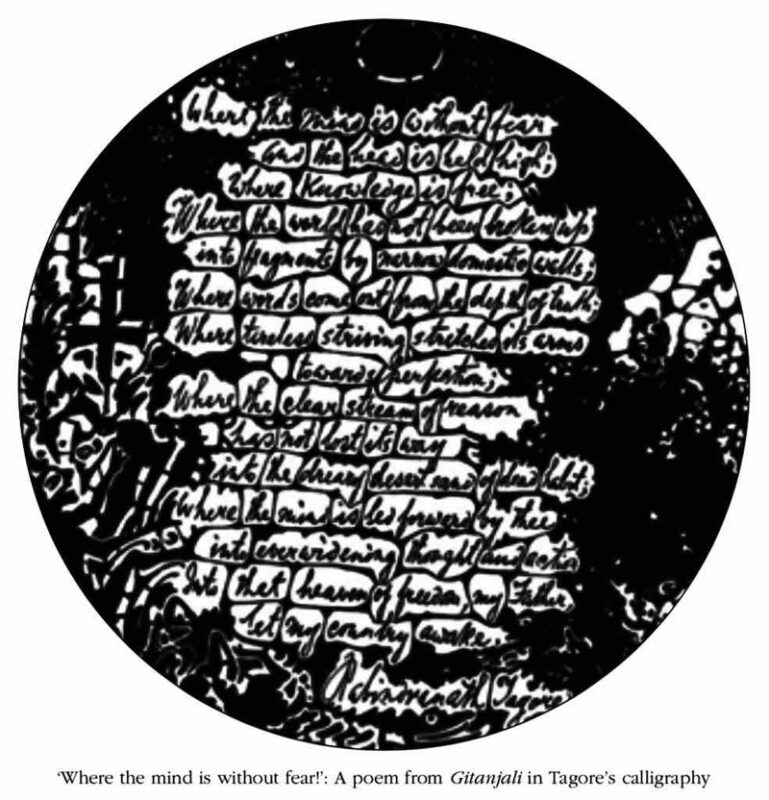
surrounding Santiniketan | UNESCO World Heritage Centre >>
Keeping Rabindranath’s ideas in mind, Surendranath Kar prepared the architectural plan and Nandalal Bose [>>Wikipedia] prepared the visual perspective based on the Borobudur style. The entire outside wall was decorated with beautiful relief work by Kala-Bhavana students under the guidance of Nandalal Bose. The Santals on either side of the main door and on the eastern corner were by Ramkinkar Baij. Gandhiji and Kasturba stayed as guests in this house. […]
The landscape of Santiniketan is dotted with sculptures by Ramkinkar Baij (1906-1980), largerthan-life figures of Santals who were in reality part of the landscape. A Santal family, complete with dog, a group of workers running along at the call of the mill, their clothes flying in the air, a thresher, all situated along the main road. […]
On 22nd December 1901, Rabindranath Tagore established his school at Santiniketan with five students (including his eldest son) and an equal number of teachers. He originally named it Brahmacharya Ashram in the tradition of ancient forest hermitages.
Santiniketan is in many ways a pioneering step in the field of education and rural reconstruction. Located in the heart of nature amongst Hindu, Muslim, and Santali villages which were in ‘serious decline’ despite a rich cultural heritage, the school, from almost its beginning aimed to combine education with a sense of obligation towards the larger civic community. The ‘voice of the vedic tongue’, Tagore said, outlined the nature of Santiniketan, envisioned as the ideal form of the traditional Indian hermitages which had at one time flourished in the forests of ancient India, great seats of learning from which the Upanishads had evolved, exploring a universal and humanistic life of the mind. Although Tagore was highly critical of Macaulay’s system due to which, unlike the West, education, particularly higher education, was cut off and insulated from the living social corpus of India. […]
While Tagore supported the idea of religious communities fostering educational research and revival of their cultures, his educational system at Santiniketan was based on plurality of cultures and religion, with even the nascent stages of Santiniketan having 2 Hindu and 3 Christian teachers. […]
Source: UNESCO World Heritage Centre website
Address : https://whc.unesco.org/en/tentativelists/5495/
Date Visited: 1 November 2022
Though outside India Tagore upheld and interpreted the Indian philosophy of life, in his own country he was the severest critic of its social institutions and religious practices which encouraged superstition and inequality and tolerated injustice. […]
The religion he preached was the religion of man, the renunciation he extolled was not of this world but of the base passions of cupidity and hatred, the freedom he fought for was not of one people to exploit another but the freedom of the human personality from all that strangles it, whether it be the tyranny of an external organization or the worse tyranny of man’s own blind ego and lust for power.
Source: Krishna Kripalani in Rabindranath Tagore: A Biography (Oxford University Press 1962, reprint Santiniketan 1980)
URL: https://archive.org/stream/in.ernet.dli.2015.39366/2015.39366.Rabindranath-Tagore—A-Biography_djvu.txt
Date visited: 17 November 2020

“[A] common perception of conversion, prevalent in India, is that all conversions take place only among deprived lower caste or tribal groups, which are considered more susceptible to allurement or coercion. The reality of upper caste conversions is ignored in this climate of cynicism.”– Dr. Ivy Imogene Hansdak in Pandita Ramabai Saraswati: the convert as ‘heretic’ | More about the effects of “casteism” >>
India Perspectives (24 No. 2/2010) | More about Tagore and rural education >>
Source: “Tagore, Gitanjali and the Nobel Prize” by Nilanjan Banerjee in

Freedom: Accountability, Childrens right to education, Democracy & Rights of Indigenous Peoples >>
Find scholarly books, poetry and fiction relating to tribal culture – Indian publishers
List of sites covered by this Google custom search engine
To find children’s and educational books or search Indian periodicals, magazines, web portals and other sources safely, click here >>
Search tips
Combine the name of any particular state, language or region with that of any tribal (Adivasi) community.
Add keywords of special interest (music, poetry, dance just as health, sacred grove and biodiversity); learn about the rights of Scheduled Tribes such as the “Forest Rights Act” (FRA); and the United Nations “Declaration on the Rights of Indigenous Peoples”, “Universal Declaration of Human Rights”, “women’s rights”, or “children’s right to education”.
Ask a question that includes “tribal” or “Adivasi”, for instance: “Adivasi way of life better?” (or “tribal way of life worse?”)
Specify any particular issue or news item (biodiversity, bonded labour and human trafficking, climate change, ecology, economic development, ethnobotany, ethnomedicine, global warming, hunter-gatherers in a particular region or state, prevention of rural poverty, water access).
For official figures include “scheduled tribe ST” along with a union state or region: e.g. “Chhattisgarh ST community”, “Himalayan tribe”, “Scheduled tribe Tamil Nadu census”, “ST Kerala census”, “Particularly Vulnerable Tribal Group Jharkhand”, “PVTG Rajasthan”, “Adivasi ST Kerala”, “Adibasi ST West Bengal” etc.
In case the Google Custom Search window is not displayed here try the following: (1) toggle between “Reader” and regular viewing; (2) in your browser’s Security settings select “Enable JavaScript” | More tips >>
Note: hyperlinks and quotes are meant for fact-checking and information purposes only | Disclaimer >>
Research the above issues with the help of Shodhganga: A reservoir of theses from universities all over India, made available under Open Access >>
Find publications by reputed authors (add “open access” for freely downloadable content)
See also
eBook | Free catalogue: Museum of Santal Culture (Bishnubati)
eBook | Free catalogue: Banam: One of the ancient musical instruments of the Santals
Santal | Santali language | Santali script – Ol Chiki
The Santhal family and the invention of a subaltern counterpublic
Tips for using interactive maps
Toggle to normal view (from reader view) should the interactive map not be displayed by your tablet, smartphone or pc browser
For details and hyperlinks click on the rectangular button (left on the map’s header)
Scroll and click on one of the markers for information of special interest
Explore India’s tribal cultural heritage with the help of another interactive map >>